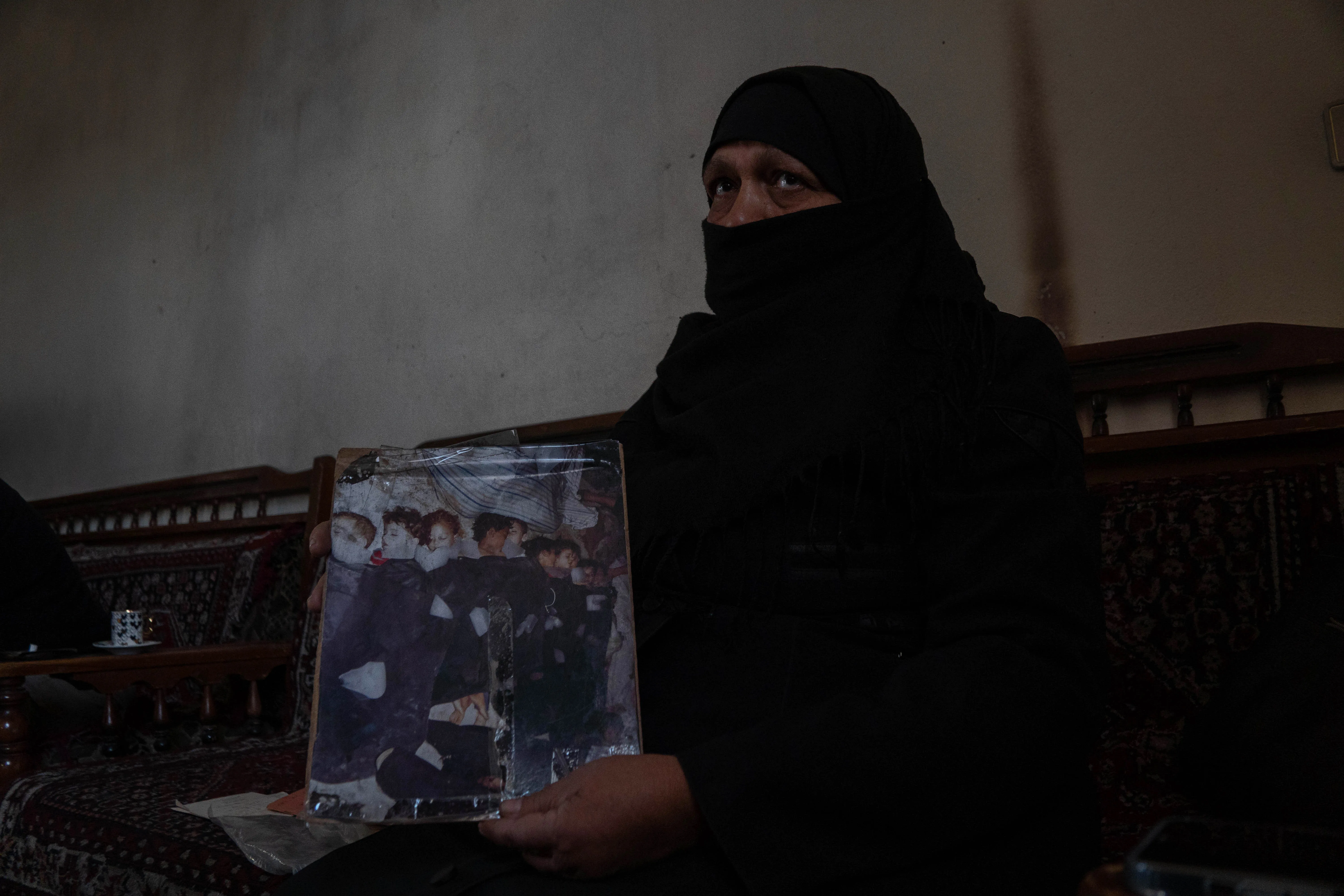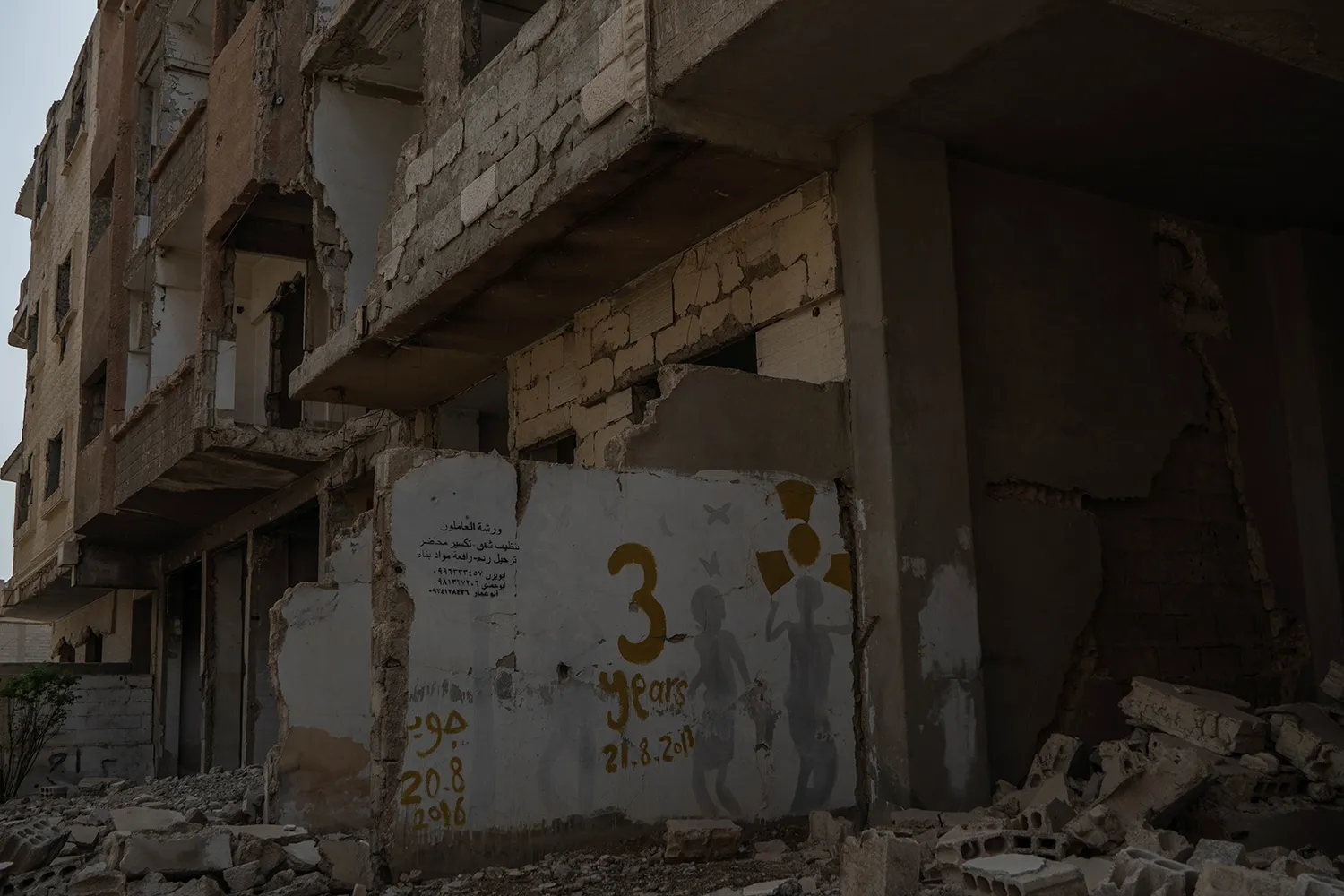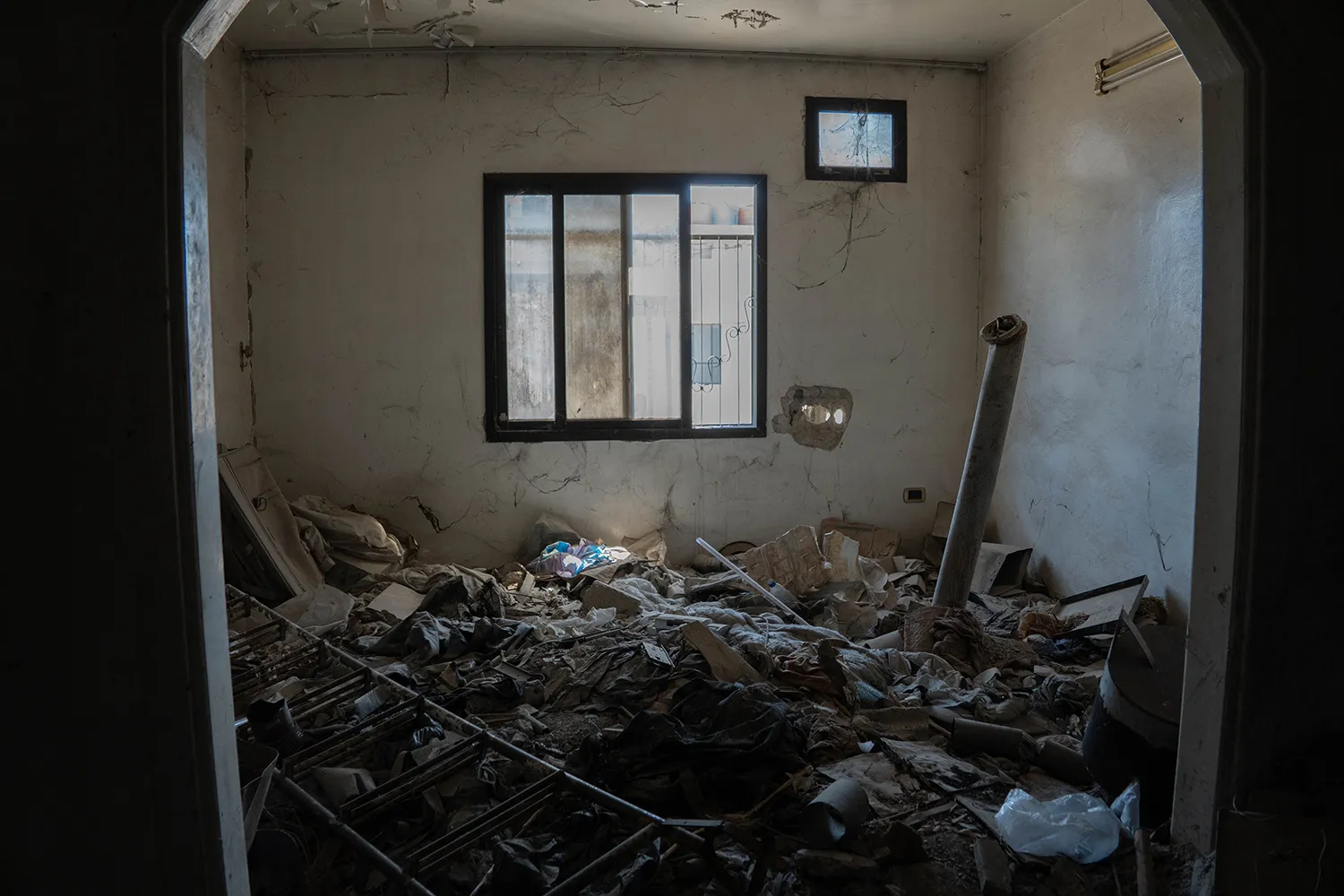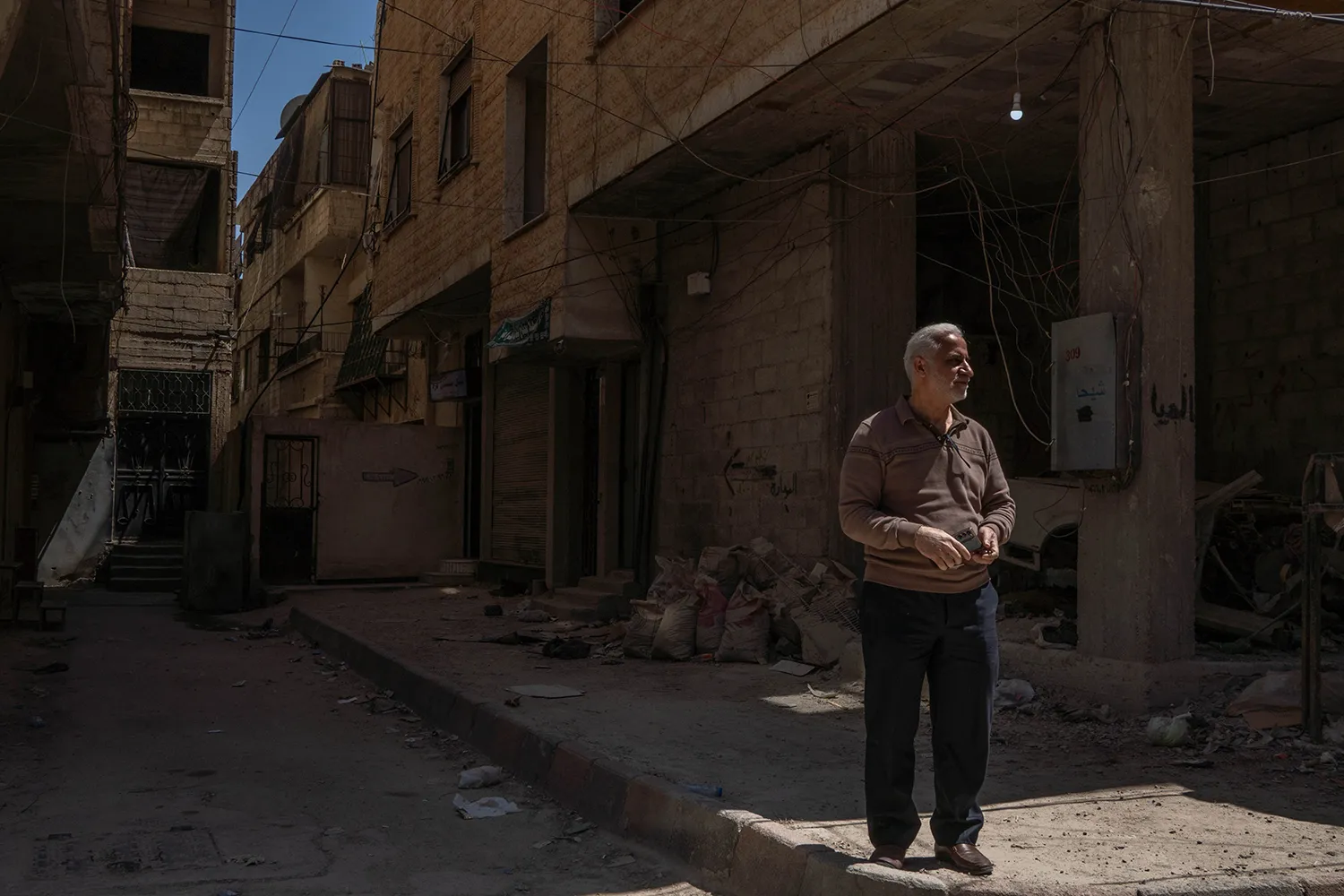In the early hours of Aug. 21, 2013, Um Mohammed was fast asleep at home in Zamalka, a town in the Ghouta area that surrounds Damascus. The screams of people on the streets woke her up: “They hit us with chemical weapons!”
Um Mohammed got up and ran outside the building, covering her nose with her shawl. Around her, her relatives began dropping to their knees; they were separated in the chaos. After a few hours, she found the bodies of her husband and one of her sons lying next to each other in her neighbor’s house. A towel that she gave her son to protect him from the toxic gas was still on his shoulder.
Nearly 12 years later, Um Mohammed still tears up when she recounts that deadly night in Ghouta. She also lost grandchildren in the attack. “It’s not just my household, it’s every family,” she said. “There’s not a single home that hasn’t lived something like this.”

Last December, a blitz offensive by rebel forces led by Hayat Tahrir al-Sham (HTS) toppled Syrian President Bashar al-Assad, ending the country’s nearly 14-year-long civil war. In the months since, Syria’s transitional government has taken swift action to confront the legacy of the Assad regime’s chemical weapons use, but the future and scope of full disarmament remains unclear.
After years of restricted access and operational ability in the country, the Organization for the Prohibition of Chemical Weapons (OPCW) expressed interest to Syria’s interim government in visiting around 100 sites that may have been tied to the Assad government’s chemical weapons program. In March, Syrian Foreign Minister Asaad Hassan al-Shaibani vowed to “destroy any remains of the chemical weapons program developed under the Assad regime,” promising justice for victims and compliance with international bodies.
However, Shaibani’s mission faces significant roadblocks. In February, U.S. President Donald Trump moved to cut a majority of funding to United States Agency for International Development (USAID) programs, some of which provide support for groups that assist with chemical disarmament. The step is forcing Syria, now finding its feet with a political new normal, to reckon with U.S. foreign policy.

In 2013, a United Nations delegation headed by Ake Sellstrom, a Swedish researcher and disarmament expert, arrived in the country to investigate allegations of chemical weapons attacks. The team was in Syria at the time of the gas attacks in Ghouta, and its investigation—which focused on the area but included testimonies from multiple regions—confirmed that the deadly nerve agent sarin was used against Syrian citizens.
A Human Rights Watch report from September 2013 established that more than 730 people were killed in the attacks on the town of Zamalka alone, according to names registered by the local council.
Sellstrom said that the terms of his team’s access, decided after extensive debate in the U.N., were that they couldn’t point fingers toward the perpetrators. But his team determined that “the chemical compounds that were used had the fingerprint of the government.” The perpetrators of the attack “knew exactly how to use [the chemicals],” he said in an interview in April.
Um Mohammed’s son Abu Ahmed was a paramedic during the August 2013 attack. He said that necessity and experience trained him for the job. “In these hospitals, even nurses were like doctors,” Abu Ahmed said, standing in a building that served as a makeshift underground clinic where people were brought after the attacks. In his hands were dusty vials of atropine, used to treat poisoning by nerve agents.
-

Abu Ahmed stands in an underground clinic in Ghouta.
-

Abu Ahmed holds atropine vials from the floor of an underground clinic in Ghouta.
Then-U.S. President Barack Obama had delineated the use of chemical weapons as a “red line” in the Syrian civil war in 2012, but the United States did not intervene militarily after the Ghouta attack. Until then, U.S. involvement was limited to aid support for certain opposition groups. (The Obama administration did greenlight strikes against Islamic State targets in Syria and Iraq in 2014.)
In October 2013, after Sellstrom’s mission released its findings, Syria joined the Chemical Weapons Convention and became a member of the OPCW, agreeing to declare and destroy its chemical weapons stockpile. A joint U.N.-OPCW mission in 2014 disposed of the chemicals. However, a 2023 OPCW report revealed that the regime continued to obtain and utilize chemical weapons after they were supposedly disposed of; they were notably used again in the Damascus suburb of Douma in 2018.
The joint U.N.-OPCW mission to disarm Syria in 2014 was carried out aboard the U.S. maritime vessel Cape Ray, using two units of a field deployable hydrolysis machine, which diluted the toxic chemicals in water to neutralize them.
“The construction of the equipment, procurement of all the ancillary equipment, provision of the ships and payment of the crews, that was all [by the] U.S. government,” said Tim Blades, director of operations at the U.S. Army Combat Capabilities Development Command Chemical Biological Center and mission commander aboard the Cape Ray, adding that there was cost-sharing with other countries.
“The U.S. did provide a lot of people, equipment, and money primarily to destroy the sarin and its immediate precursors,” said John Gilbert, a senior science fellow at the Center for Arms Control and Non-Proliferation’s Scientists Working Group.
In 2017 and 2018, during Trump’s first term, the United States conducted multiple airstrikes in Syria, including targeting facilities in the Scientific Studies and Research Center in Barzeh (SSRC). The strikes were allegedly related to the country’s chemical weapons program, according to a director at the Joint Chiefs of Staff. The facility was widely considered to be the core of Syria’s chemical weapons program.

In Trump’s second term, U.S. policy is now impeding the disarmament process in Syria. The White House decision to cut USAID funding affects Syria’s White Helmets, officially known as the Syrian Civil Defense. Before the fall of Assad’s regime, the White Helmets worked extensively in opposition-held areas, and they were the target of many disinformation campaigns by Assad and his allies.
Working alongside the OPCW, the White Helmets are now an integral part of investigating chemical weapon capabilities in Syria. The United States is one of the organization’s largest donors: As of March 21, a $30 million USAID contract to the White Helmets had been terminated. The White Helmets declined to comment on the USAID freeze on investigations related to chemical weapons in Syria, as it was “still under discussion and reevaluation,” according to a spokesperson.
Experts say that U.S. funds play a vital role in chemical disarmament in Syria. “U.S. support for international organizations that seek to dismantle or remove chemical weapons is important to [their] functioning,” said Nicholas Heras, the director of the Middle East Center at the New Lines Institute, a Washington-based think tank. “[This] financial and technical support will need to be replaced by other countries, or those organizations will become ineffective.”
Heras expects that the Trump administration would likely rely on Turkey as an intermediary in providing intelligence to Syria’s transitional government about chemical weapons stockpiles, while allowing Israel to bomb stockpiles.
Since the fall of the Assad regime, Israel has conducted airstrikes in Syria, including in the vicinity of the SSRC in April. Israel said the strikes were meant to serve as a “warning for the future,” directed at potential anti-Israel forces. “There is little appetite right now from the Trump team to make bold moves in Syria, except if Israel’s national security is threatened by actors based in Syria,” Heras said.
Gilbert echoed that negotiating with Syria is “very low on [America’s] list of priorities.” “At present I think the U.S. administration is worried about other things than Syrian chemical weapons,” he said.

Residents in Syria, however, are disillusioned by the prospect of Western involvement. Nabeel Ghurra, a doctor from Zamalka who lost five children to the chemical attacks, said that the United States should “leave the new government that has taken power alone.”
“The whole West protected Assad, honestly. [The United States] said so many times that Assad would be toppled—then Obama came, and Trump in the first term, and Assad stayed,” Ghurra said. “It shows the hypocrisy of the West.”
Investigations into Syria’s chemical weapon stockpile are still ongoing, which will determine the details of disarmament in the months to come. Meanwhile, many USAID-funded humanitarian programs in the country are facing job cuts and financial shortfalls. As the Trump administration enacts its “America First” foreign policy, the future of chemical weapons stockpiles in Syria and the long-held hope for justice by Syrian families remains blurry.
The post The Long Shadow of Syria’s Chemical Weapons appeared first on Foreign Policy.




